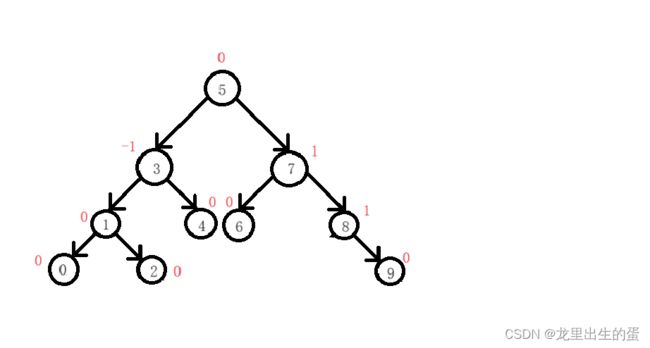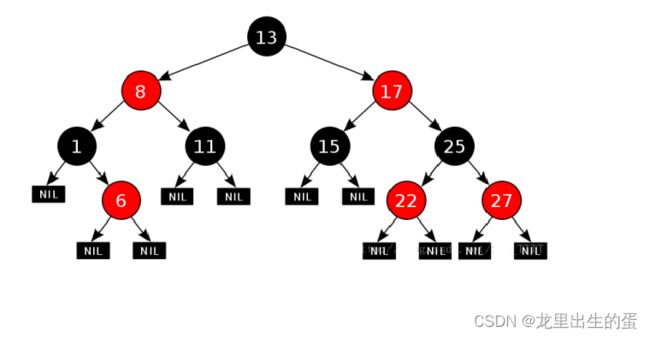【C++ map、set】
目录
- 一、什么是AVL树
-
- 1.1AVL树的发展背景
- 1.2AVL树的概念
- 二、AVL树的插入实现
-
- 2.1 AVL树实现的框架
- 2.2AVL树插入的算法思想
- 2.3AVL树插入的代码实现
- 2.4AVL树插入及验证的代码实现
- 三、什么是红黑树
-
- 3.1红黑树的背景
- 3.2红黑树的性质
- 四、红黑树的插入实现
-
- 4.1红黑树插入的算法思想
- 4.2红黑树插入的代码实现
- 4.3红黑树插入及验证的代码实现
一、什么是AVL树
1.1AVL树的发展背景
我们都知道搜索树的效率最高的时候就是搜索树最满(满二叉树)的时候。但是现实中的搜索树可能是这个样子。如下图:

那这样的搜索树跟一个查找的效率跟一维数组没什么区别。为了避免出现这样的情况,所以引入了AVL树。
1.2AVL树的概念
发明了一种解决上述问题的方法:当向二叉搜索树中插入新结点后,如果能保证每个结点的左右子树高度之差的绝对值不超过1(需要对树中的结点进行调整),即可降低树的高度,从而减少平均搜索长度。

二、AVL树的插入实现
2.1 AVL树实现的框架
为了方便代码的编写,在树的结点中要有平衡因子、左节点、右节点、父亲结点等
template<class K,class V>
struct TreeNode
{
TreeNode<K, V>* _left;
TreeNode<K, V>* _right;
TreeNode<K, V>* _parent;
pair<K, V> _p;
int _bf;
TreeNode(const pair<K, V>& p)
:_left(nullptr)
, _right(nullptr)
, _parent(nullptr)
, _p(p)
, _bf(0)
{}
};
template<class K,class V>
class AVLTree
{
typedef TreeNode<K, V> Node;
public:
AVLTree()
:_root(nullptr)
{}
private:
Node* _root;
};
2.2AVL树插入的算法思想
2.3AVL树插入的代码实现
#pragma once
#include2.4AVL树插入及验证的代码实现
#include"RBTree.h"
#include"AVLTree.h"
#include rb;
//for (auto e : arr)
//{
// rb.insert(make_pair(e,e));
// cout << "insert:" << e << "->" << rb.isBalance() << endl;
//}
int arr[] = { 4,2,6,1,3,5,15,7,16,14 };
AVLTree<int, int> at;
for (auto e : arr)
{
at.insert(make_pair(e, e));
cout << "insert:" << e << "->" << at.isBalance() << endl;
}
随机数测试(RBTree)
//const int N = 10000;
//srand((unsigned)time(0));
//RBTree rb;
//for (int i = 0; i < N; i++)
//{
// rb.insert(make_pair(rand(), rand()));
//}
//cout << rb.isBalance() << endl;
//随机数测试(AVLTree)
const int N = 10000;
srand((unsigned)time(0));
AVLTree<int, int> at;
for (int i = 0; i < N; i++)
{
at.insert(make_pair(rand(), rand()));
}
cout << at.isBalance() << endl;
return 0;
}
三、什么是红黑树
3.1红黑树的背景
由于上面的AVL树对平衡的机制太过于严格,导致在插入的过程中要多次旋转树的结点,所以引入了这个叫红黑树。如图:

3.2红黑树的性质
1.树的结点颜色不是红色就是黑色
2.如果父亲的颜色是红色,它的儿子只能是黑色
3.最长路径不超过最短路径的二倍
4.根结点是黑色
5.每个路径下的黑色结点数相同
四、红黑树的插入实现
4.1红黑树插入的算法思想
4.2红黑树插入的代码实现
#pragma once
#include4.3红黑树插入及验证的代码实现
#include"RBTree.h"
#include"AVLTree.h"
#include at;
//for (auto e : arr)
//{
// at.insert(make_pair(e, e));
// cout << "insert:" << e << "->" << at.isBalance() << endl;
//}
//随机数测试(RBTree)
const int N = 10000;
srand((unsigned)time(0));
RBTree<int, int> rb;
for (int i = 0; i < N; i++)
{
rb.insert(make_pair(rand(), rand()));
}
cout << rb.isBalance() << endl;
随机数测试(AVLTree)
//const int N = 10000;
//srand((unsigned)time(0));
//AVLTree at;
//for (int i = 0; i < N; i++)
//{
// at.insert(make_pair(rand(), rand()));
//}
//cout << at.isBalance() << endl;
return 0;
}

